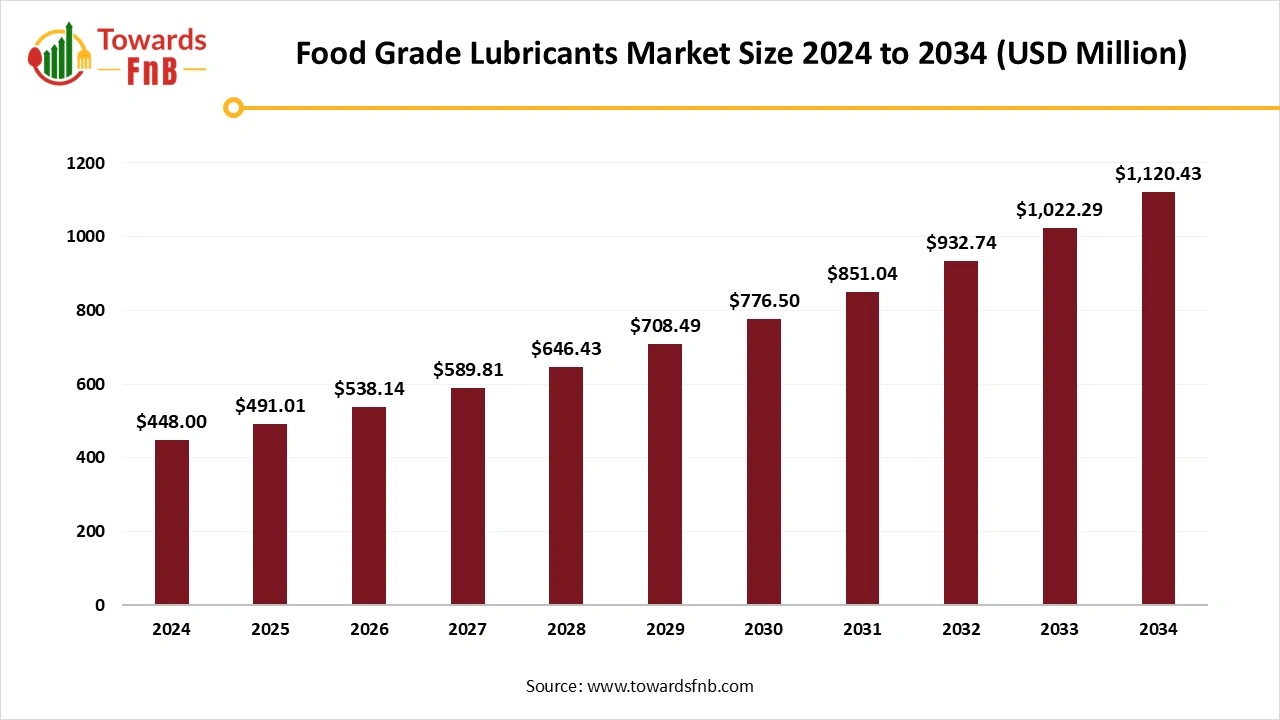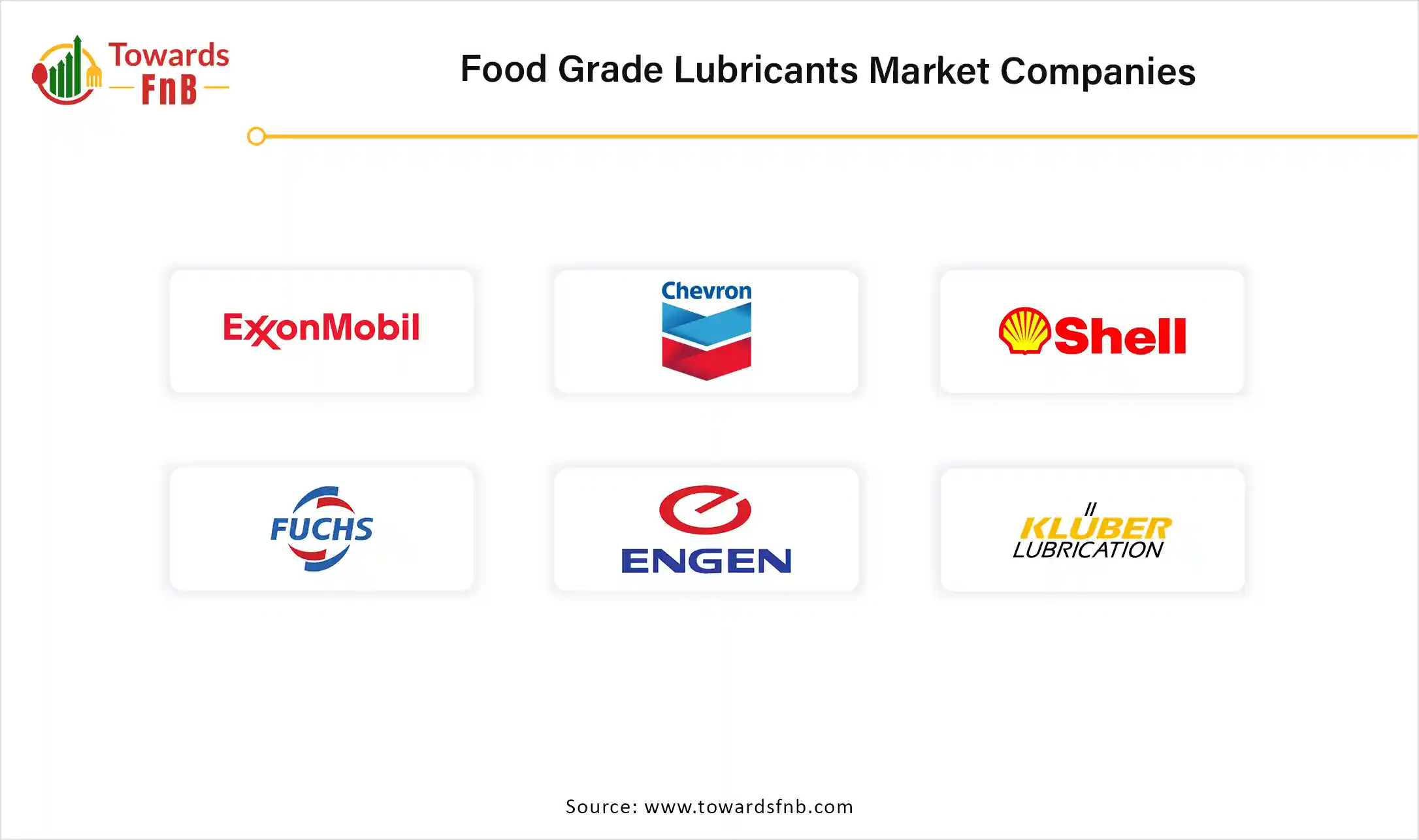November 2025
The global food grade lubricants market size was reached at USD 448 million in 2024 and is forecast to rise from USD 491.01 million in 2025 to approximately USD 1,120.43 million by 2034, with a CAGR of 9.6% during the forecast period from 2025 to 2034. The increased efforts of manufacturers in ensuring the reproducible properties of food-grade lubricant materials showcase their versatility, efficiency, and enhanced performance.

| Study Coverage | Details |
| Growth Rate from 2025 to 2034 | CAGR of 9.6% |
| Market Size in 2025 | USD 491.01 Million |
| Market Size in 2026 | USD 538.14 Million |
| Market Size by 2034 | USD 1,120.43 Million |
| Largest Market | North America |
| Base Year | 2024 |
| Forecast Period | 2025 to 2034 |
| Regions Covered | North America, Europe, Asia-Pacific, Latin America, and Middle East & Africa |
Food lubricants or food-grade lubricants deliver several benefits such as protection against corrosion, friction, wear, and oxidation. They exhibit good compatibility with rubber or other sealing materials, which provides a good sealing effect in certain cases. H1, H2, and H3 are the original food grade designations introduced by the U.S. Department of Agriculture (USDA). The H1 lubricants contribute to food processing environments; H2 lubricants are used on equipment while H3 lubricants are used to prevent rust on equipment. They are reproducible products that have specific applications and improve machinery health. These major rationales drive the growth and expansion of the food lubricants market across the globe.
2024 Sustainability Highlights of BP Plc, the Leading Company in Food Lubricants
Net Zero Operations:
Net Zero Sales
There is an adoption of predictive maintenance and condition monitoring technologies that help in the identification of potential equipment failures. They also help in the optimization of maintenance schedules. Industry 4.0 is the fourth industrial revolution that has transformed manufacturing operations. The integration of IoT, big data analytics, and artificial intelligence leads to smart industrial operations.
The extreme temperatures, high pressures, and exposure to steam, water, and chemicals pose challenges for lubrication systems. It is necessary for lubricants to meet stringent purity standards, prevent leaching, etc. The lubricants can get degraded due to frequent sanitation and cleaning, which reduces their effectiveness over time.
North America Dominated the Food Lubricants Market in 2024.
The national oil companies in the Middle East and other regions make efforts to balance the supply of crude oil and fulfill the demand by maintaining stability in prices. They also focus on sustaining their economies and reducing the industrial carbon footprint. The Middle Eastern nations are working to scale up technologies such as carbon capture and storage. There are approvals for projects related to carbon capture, utilization, and storage. Countries like Oman and Qatar are trying advancements in hydrogen production.
How does the Refining and Marketing Sector Encourage the Growth of the U.S.?
There is an expansion of direct processing capacity, availability of local processing, enhanced financing, and improved workforce training in the U.S. market. Moreover, food safety compliance with smaller industrial facilities fosters research and innovation. The USDA made a strategic partnership with the State Attorneys General which aims to expand resources and enhance best practices in the food and agriculture sector.
Asia Pacific is Expected to Witness the Fastest Rate of Growth in the Food Lubricants Market During the Predicted Timeframe.
BP Plc is one of the leading companies in food lubricants in the Asia Pacific region. The major contribution of community organizations, business representatives, and local councils results in the management of food and energy poverty. Bp Plc completed 10 years of social investment by investing $30 million to drive more than 150 projects. These projects were subjected to education, enterprise development, and environmental sustainability.
How do the Transition Investments led by Prominent Companies Boost the Expansion of the Market across Asian Pacific Countries?
One of the leading companies, called Bp Plc, reported its $3.7 billion transition growth investment and set its positive approach towards capital investment. The company also reported its investment in low-carbon activity and higher investments in bioenergy, electric vehicle charging, and wind businesses. It has set its goal of net-zero greenhouse gas emissions (GHG reduction) to achieve net-zero emissions across all of its operations.
Europe is Seen to Grow at a Notable Rate in the Food Lubricants Market in 2024.
The growing businesses and expanding partnerships in various sectors like bioenergy, electric vehicle charging, renewables, power, and hydrogen drive the overall growth of the European market. These major rationales create commercial opportunities which contribute to reducing the carbon intensity of the energy products that are subjected to sales. The expansion of supplying power to industrial and commercial customers also contributes to the market’s growth in Europe.
How does Governance Contribute to the Expansion of the Market in Germany?
The board of the regulatory authorities plays a major role in monitoring the management and operations of companies. The safety and sustainability committee of the board ensures the effective implementation of the sustainability frame. It also meets the management of health, safety, social risks, human risks, and environmental risks. The board ensures the allocation of capital across the product portfolio of companies.
The Mineral Segment Dominated the Food Lubricants Market in 2024.
The benefits of minerals in marine applications and storage solutions drive their remarkable growth in the market. The characteristic features of minerals such as dielectric properties and cooling effects make them good solutions for usage. The mineral oil used in food grade lubricants does not get contaminated while it acts as an active ingredient in ointments and creams in pharmaceutical products.
The Bio-Based Segment is Expected to Witness the Fastest Rate of Growth in the Market During the Predicted Timeframe.
The bio-based lubricants are advantageous due to better lubrication, superior viscosity, better thin film strength, and lower volatility. Moreover, there is good pressure performance, higher flash points, less smoke, and less risk of fire. They exhibit applications related to gearing and water-soluble coolants and allow easy cleanup and real-world experience.
The Food Segment Dominated the Food Lubricants Market in 2024.
Food grade lubricants like H1 lubricants play a major role in maintaining compliance with food safety regulations. They are ideally used as coatings on eggs, vegetables, and fruits and as defoaming agents. The importance of food safety and machinery lubrication in food and beverage production drives the adoption of food lubricants in the market.
The Beverages Segment is Observed to be the Fastest Growing in the Food Lubricants Market During the Forecast Period.
Food lubricants are essential in the manufacturing processes of the beverage industry to ensure smooth and efficient industrial operations. The honourable position of the National Sanitation Foundation (NSF) certification as a food safety standard introduced by global regulatory authorities helps to build trust within companies and meet global consumer needs.
ExxonMobil Corporation
Chevron Corporation

By Product
By Application
By Region
November 2025
November 2025
November 2025
November 2025